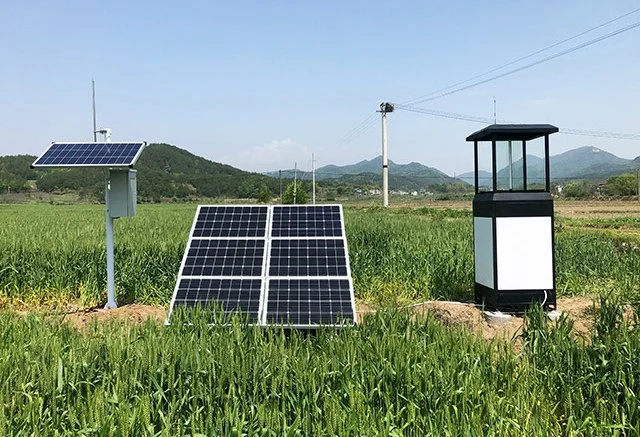
- Introduction to Smart Sensors for Insect Detection
- How Smart Sensors Detect Insects
- Benefits of Using Smart Sensors for Insect Detection
- Types of Smart Sensors Used for Insect Detection
- How to Install and Use Smart Sensors for Insect Detection
1. Introduction to Smart Sensors for Insect Detection
As technology advances, smart sensors are becoming a revolutionary tool in pest control, particularly for detecting insects. These sensors are designed to detect pests like ants, cockroaches, termites, and other unwanted insects before they become a major problem. Using smart sensors for insect detection offers a proactive approach to pest management, allowing you to take action before an infestation spreads.
1.1. What Are Smart Sensors?
Smart sensors are advanced devices equipped with technology that allows them to detect specific environmental changes, such as movements, sounds, or vibrations, associated with the presence of insects. These sensors are connected to a network or smart device, allowing for real-time monitoring and alerts.

Central Pest Control
Mount PleasantIsabella CountyMichigan
11274 E Valley Rd, Mt Pleasant, MI 48858, USA
1.2. Why Choose Smart Sensors for Pest Control?
Traditional pest control methods, such as using traps or sprays, often provide reactive solutions, whereas smart sensors enable a proactive approach. By detecting insects early, these sensors help minimize damage and reduce the need for harsh chemicals, making them a more sustainable option for pest management.
2. How Smart Sensors Detect Insects
Smart sensors use various methods to detect insects, depending on the technology incorporated into the device. These methods typically involve monitoring changes in the environment that signal the presence of pests, such as temperature fluctuations, movement, or specific sounds. Here are some ways smart sensors work:
2.1. Motion Sensors
Many smart sensors use motion detection to identify insects. These sensors can detect movements as small as the movement of an insect's legs or wings. When an insect passes within the sensor’s range, it triggers an alert, letting you know that it has been detected.
2.2. Acoustic Sensors
Acoustic sensors are designed to detect the sounds produced by insects, such as the chirping of crickets or the tapping of termites as they chew through wood. These sensors capture these sounds and use them to identify potential infestations.
2.3. Temperature and Humidity Sensors
Insects are sensitive to environmental conditions, and temperature and humidity changes can often indicate their presence. Some smart sensors monitor fluctuations in temperature and humidity that are associated with insects like termites or ants. These sensors can trigger alerts when they detect unusual changes in the environment that may suggest an infestation.
3. Benefits of Using Smart Sensors for Insect Detection
Using smart sensors for insect detection comes with a range of advantages. Not only do these sensors make pest control more efficient, but they also offer a variety of benefits that can improve both the quality of your pest management and the comfort of your home or business.
3.1. Early Detection
One of the primary benefits of using smart sensors for insect detection is early detection. By identifying pests early, you can prevent them from spreading and causing significant damage. Early detection allows you to address issues before they escalate into full-blown infestations.
3.2. Reduced Chemical Use
With real-time monitoring and alerts, smart sensors help reduce the need for chemical treatments. By identifying the presence of insects without the need for invasive sprays, these sensors offer a more environmentally friendly and sustainable approach to pest control.
3.3. Remote Monitoring and Alerts
Smart sensors allow for remote monitoring, which means you can keep track of pest activity even when you’re not at home. Through smartphone apps or connected devices, you can receive instant notifications and updates about insect activity, giving you the opportunity to act quickly.
3.4. Cost-Effective
Over time, using smart sensors can be more cost-effective than traditional pest control methods. By detecting insects early, you can avoid expensive treatments or repairs caused by extensive damage from pests. Additionally, you only need to address issues when the sensors detect pests, reducing unnecessary interventions.
4. Types of Smart Sensors Used for Insect Detection
There are several different types of smart sensors used in insect detection, each designed for specific needs and environments. Let’s explore some of the most popular types:
4.1. Ultrasonic Sensors
Ultrasonic sensors emit sound waves that are inaudible to humans but can detect the movement of insects. These sensors are particularly effective for detecting pests like cockroaches or rodents, which are sensitive to ultrasonic frequencies.
4.2. Camera-Based Sensors
Camera-based sensors can be used in conjunction with image recognition software to detect insects. These sensors capture images or videos of the environment and use AI to identify potential pest activity. While these sensors are more advanced, they offer highly accurate detection for various types of insects.
4.3. Smart Traps
Smart traps are another type of sensor that not only captures insects but also sends alerts when they are trapped. These sensors monitor the trap and notify you when it’s time to check or reset it. Smart traps are often used for insects like flies, ants, and mosquitoes.
5. How to Install and Use Smart Sensors for Insect Detection
Installing and using smart sensors for insect detection is relatively straightforward, but proper placement and maintenance are key to their effectiveness. Here’s how to get started:
5.1. Choose the Right Location
When installing smart sensors, choose locations where insects are most likely to be present, such as near entry points, food storage areas, or high-humidity zones. For example, placing sensors near windows or doors can help detect pests trying to enter from outside, while sensors in the kitchen or pantry can identify pests attracted to food.
5.2. Set Up the Sensor and Connect to Your Device
Most smart sensors come with easy-to-follow installation instructions. After installing the sensor, connect it to your smartphone or a smart hub through an app or network. This will allow you to receive real-time alerts and track insect activity remotely.
5.3. Regular Maintenance and Calibration
Regular maintenance is essential for ensuring that your sensors continue to work efficiently. Periodically check the sensors to ensure they are clean, properly calibrated, and functioning correctly. This helps maintain accuracy and reliability in insect detection.
Smart sensors offer an innovative and effective way to detect insects early and prevent infestations before they become a problem. If you’re looking for the best smart sensors for insect detection, visit PestControlHub for a wide range of products tailored to your needs. Whether you’re looking for motion sensors, traps, or advanced camera-based systems, we have the solutions to keep your space pest-free.








 Wildlife Resolutions4.0 (443 reviews)
Wildlife Resolutions4.0 (443 reviews) Pest Marshals of Toledo5.0 (2 reviews)
Pest Marshals of Toledo5.0 (2 reviews) LS Rodent Proofing & Pest Control Service5.0 (4 reviews)
LS Rodent Proofing & Pest Control Service5.0 (4 reviews) Best Termite & Pest Control4.0 (16 reviews)
Best Termite & Pest Control4.0 (16 reviews) Varment Guard Wildlife Services5.0 (28 reviews)
Varment Guard Wildlife Services5.0 (28 reviews) Pestban Inc4.0 (394 reviews)
Pestban Inc4.0 (394 reviews) How to Use Monitors to Detect Pest Entry: A Comprehensive Guide
How to Use Monitors to Detect Pest Entry: A Comprehensive Guide How to Predict Which Pests Will Invade Next – Smart Pest Forecasting for the U.S.
How to Predict Which Pests Will Invade Next – Smart Pest Forecasting for the U.S. How to Conduct a Pest Risk Assessment at Home – Expert Guide
How to Conduct a Pest Risk Assessment at Home – Expert Guide How to Block Pest Entry Around Deck Joists: Effective Solutions
How to Block Pest Entry Around Deck Joists: Effective Solutions How to Safely Use Fumigation Methods: A Comprehensive Guide for Homeowners
How to Safely Use Fumigation Methods: A Comprehensive Guide for Homeowners Why Pests Are More Active After Rain: Understanding the Link Between Weather and Pest Behavior
Why Pests Are More Active After Rain: Understanding the Link Between Weather and Pest Behavior